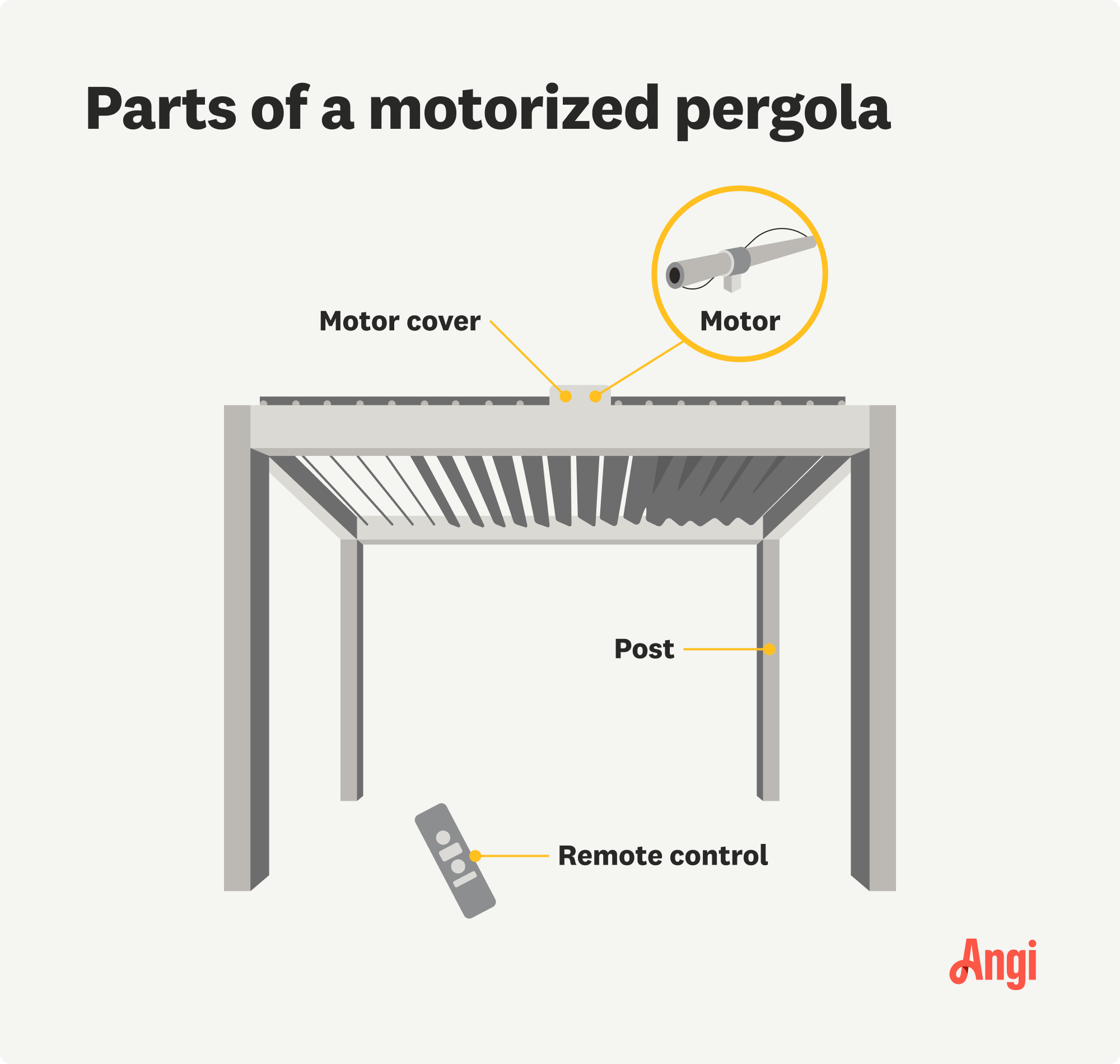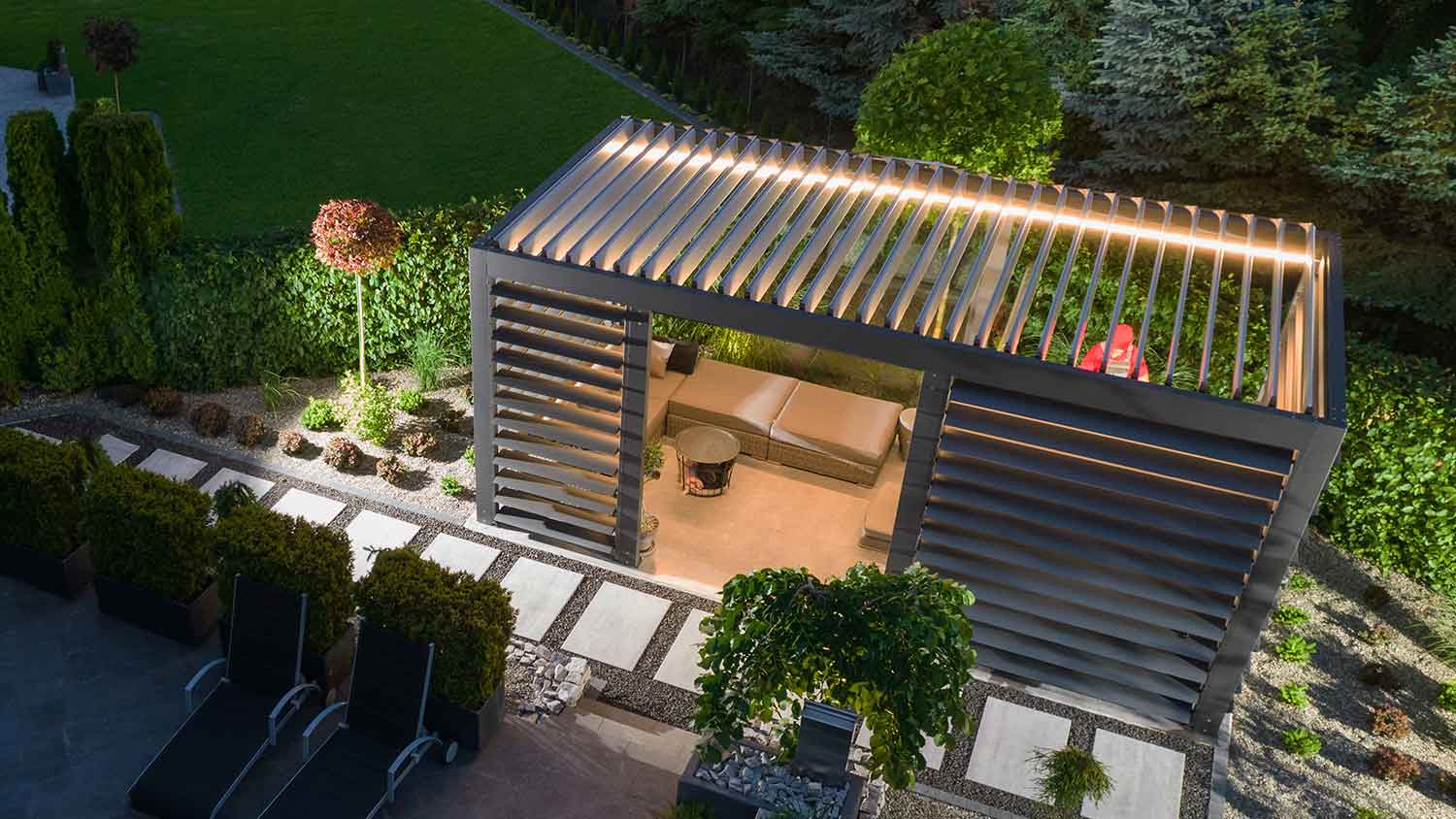How Much Does a Motorized Pergola Cost? [2025 Data]
A motorized pergola costs $7,500 to $22,500 for most people, or an average of $13,700. What you pay for your pergola depends on the material you choose, its size, and labor costs in your area.


A motorized pergola costs $13,700 on average, with prices ranging from $3,900 for an 8-foot-by-8-foot motorized pergola to over $50,000 for a 20-foot-by-20-foot smart pergola with extra features like rain sensors.
Size is a common cost factor for motorized pergolas, and the bigger the pergola, the more you’ll pay. For a motorized pergola, expect to spend around $60 to $180 per square foot, with the average pergola spanning about 12 feet by 12 feet. A motorized pergola isn’t just an attractive outdoor feature—this convenient structure can let in sunlight or provide shade and cover from rain with just the touch of a button, so start your budget here.
Motorized Pergola Cost Breakdown
With motorized pergola costs ranging anywhere from $3,840 to over $72,000, it’s clear that there are a wide variety of factors that influence the final cost of installing this outdoor structure. From the material of the pergola to its size to the add-on features you choose, here are the top cost factors to consider when installing a motorized pergola.
Type

While a standard pergola without an operable roof costs around $10 to $60 per square foot, motorized pergolas can range from $60 to $130 per square foot. Smart pergolas may cost more, up to $180 per square foot.
Keep in mind that a manual louvered pergola isn’t going to be motorized; instead, you’ll need to open and shut the roof using a crank or cable pulley system. However, if you find that the motorized pergola cost is out of your budget, a manual system can offer more flexibility than a standard pergola with a non-retractable roof at a lower cost than a smart or motorized pergola.
| Pergola Type | Average Cost per Square Foot |
|---|---|
| Motorized | $60–$130 |
| Smart | $80–$180 |
| Manual | $50–$110 |
| Non-retractable | $10–$60 |
Size
The cost of a motorized pergola depends on the size, with costs ranging from around $60 to $180 per square foot. Smart models fall on the higher end of this range, and adding features like additional sensors, lighting, curtains, custom colors, or high-end materials can increase the cost further.
By comparison, a basic pergola costs about $10 to $60 per square foot, but it won’t feature the convenient motorized cover, which can quickly protect your patio space from sudden rainstorms or bright sunshine.
| Pergola Size (Feet) | Average Cost |
|---|---|
| 8x8 | $3,840–$11,520 |
| 10x10 | $6,000–$18,000 |
| 11x11 | $7,260–$21,780 |
| 10x14 | $8,400–$25,200 |
| 12x12 | $8,640–$25,920 |
| 12x14 | $10,080–$30,240 |
| 12x18 | $12,960–$38,880 |
| 14x18 | $15,120–$45,360 |
| 16x16 | $15,360–$46,080 |
| 16x20 | $19,200–$57,600 |
| 20x20 | $24,000–$72,000 |
Material
Motorized pergolas typically feature a weatherproof fabric covering, but you can decide what frame material you prefer. Vinyl and aluminum tend to fall on the lower end of the $60 to $180 per square foot cost range for motorized pergolas, while wood and fiberglass cost more. Most pergolas will last about 15 to 20 years with proper maintenance; wood tends to require the most maintenance, while vinyl and fiberglass require minimal upkeep.
| Pergola Material | Average Cost per Square Foot |
|---|---|
| Wood | $25–$50 |
| Vinyl | $10–$30 |
| Aluminum | $10–$30 |
| Fiberglass | $60–$80 |
Brand
Pergolas cost about $50 to over $180 per square foot, depending on not just the size and features but also the brand. When shopping for a pergola by brand, see what each brand offers in terms of durability and warranty.
Perhaps you paid for the cost of Trex decking, and you’re looking to stick with the same brand for your new pergola, or you’re looking for a popular but budget-friendly option. There are many trusted pergola brands out there to consider.
| Brand | Average Cost per Square Foot |
|---|---|
| Azenco | $50–$120 |
| Equinox | $70–$180 |
| Outdoor Elements | $50–$90 |
| StruXure | $60–$180 |
| Trex | $60–$100 |
| Vergola | $90–$180 |
Add-On Features

To make the most of your pergola, you can incorporate unique pergola ideas like a heating or cooling system, curtains or screens for privacy, and even automated lighting to brighten the space in the evenings. These additional features can range from around $50 for some basic curtains to over $4,000 to wire and install a weatherproof outdoor ceiling fan.
| Extra Feature | Average Cost |
|---|---|
| Weather sensor | $125–$200 each |
| Heater | $300–$2,000 |
| Misting system | $500–$2,000 |
| Curtains | $50–$200 |
| Built-in gutters | $4 to $30 per linear foot |
| Automatic lighting | $50–$500 each |
| Outdoor ceiling fan | $70–$4,000 |
| Outdoor kitchen | $6,000–$26,000 |
| Mosquito treatment | $350–$500 per season |
Labor
Hiring a pergola installation professional is the safest, quickest option for building a pergola, and labor will cost about 20% to 30% of the project total. So, if your 12-foot-by-12-foot motorized pergola costs around $13,680, expect to spend about $2,750 to $4,110 of that total for labor. Larger pergolas or pergolas with more add-ons will add more in labor costs.
Motorized Pergola Ongoing Expenses

While even non-motorized pergolas need a little attention with sealant and paint from time to time, a motorized pergola comes with additional ongoing costs to consider before purchasing.
Operating Costs
A motorized pergola may be powered by electricity, batteries, or solar power. A solar-powered pergola may cost more upfront, but it shouldn’t add to your electrical bill as an ongoing cost. If you don’t have an outlet to plug your pergola into, expect to spend $150 to $260 for the cost to install an outdoor outlet. You’ll also need to pay the electrical costs set by your utility or for battery replacements, depending on your motorized pergola system.
Maintenance
Many pergolas need a fresh coat of sealant or paint every one to three years to prevent damage from rain, snow, wind, and UV rays. Metal benefits from a sealant to protect against rust, and wood will need to be repainted or resealed to protect against wood rot and pests. This maintenance will cost about $2 to $5 per square foot.
DIY Motorized Pergola Installation vs. Hiring a Pro
Savvy DIYers may be able to install their own motorized pergola with a pergola kit, which starts around $3,000 to $5,000 and quickly goes up from there. However, this is a huge project. You need to properly anchor and support the pergola or risk it falling down and not only breaking but also injuring your loved ones.
Instead, it’s best to leave the installation to a local pergola contractor who can also help you obtain the proper permits, safely secure the pergola in place, and ensure the motor and any custom or add-on features are working properly.
Tips for Saving Money on Motorized Pergola Installation
Installing any pergola, especially a motorized or smart pergola, can be a worthwhile investment to make your outdoor living space more functional. However, this project can have a high upfront cost. If you’re looking to install a motorized pergola but want to stick to a specific budget, you can save money by:
Considering materials: Materials like vinyl or aluminum are low-maintenance and long-lasting. Fiberglass may cost more upfront, but it may last longer than wood, which requires the most maintenance (and involves ongoing maintenance costs that add up).
Skipping add-ons: You don’t have to add heaters, motion-sensor lights, or ceiling fans to enjoy your outdoor space. Skip these add-ons upfront to save, then install them down the line when your budget allows.
Trying a DIY kit (if you’re experienced): If you’ve built sheds, garages, or other large structures in the past, you might be able to build a pergola yourself to save on labor costs.
Going prefab: If you’re not confident in your building skills, you can still save by opting for a prefabricated pergola that a professional can install for you.
How Angi Gets Its Cost Data
Home is the most important place on earth, which is why Angi has helped more than 150 million homeowners transform their houses into homes they adore. To help homeowners with their next project, Angi provides readers with the most accurate cost data and upholds strict editorial standards. We extensively research project costs to develop the pricing data you see, so you can make the best decisions for you and your home. We rely on reputable sources, including the U.S. Bureau of Labor Statistics, academic journals, market studies, and interviews with industry experts—all to ensure our prices reflect real-world projects.
Want to help us improve our cost data? Send us a recent project quote to costquotes@angi.com. Quotes and personal information will not be shared publicly.
Frequently Asked Questions
Pergolas cost less to build yourself because you can save on labor costs. However, improper installation not only shortens the lifespan of your pergola but also makes it unsafe and could violate local building codes, which could cost you hundreds or thousands in fees. If you want to install a pergola while saving money, consider having professionals install a prefabricated pergola kit for you.
Pergolas may have a 50% to 80% return on investment, whether they’re standard, manual, motorized, or smart pergolas. Your pergola will add more value when you choose a structure made from durable, long-lasting materials and when the pergola is properly installed by a professional. Extra features like a motorized roof, smart louvers, and heaters or misters may give you a better ROI.
A pergola needs to be anchored, and typically, concrete is the best anchor option. Pergolas should be anchored to a concrete slab or concrete footings, and this is commonly required by municipal building codes. When applying for a permit to install a pergola, be sure to check the anchoring requirements as well.















